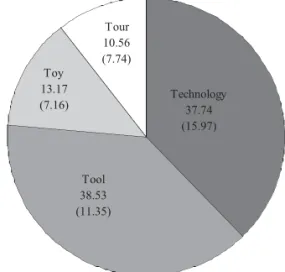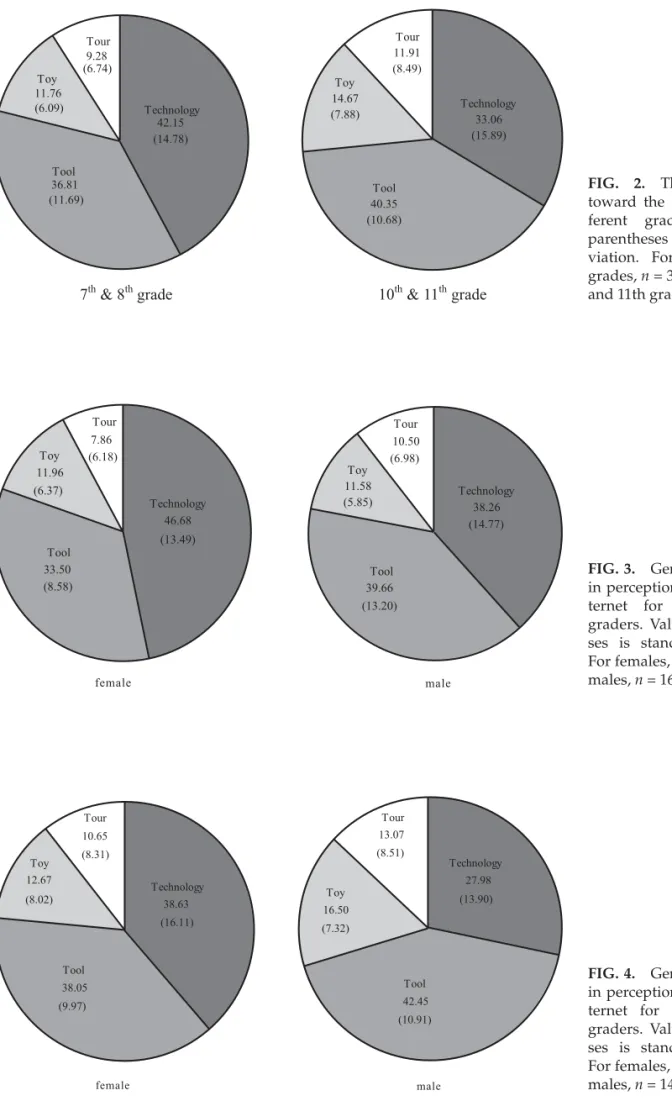767
What Is the Internet?
Taiwanese High School Students’ Perceptions
CHIN-CHUNG TSAI, Ed.D.ABSTRACT
This study gathered 588 Taiwan high school students’ responses about their perceptions of the Internet. The high school students highlighted the views that the Internet was a technol-ogy and a tool. Further analyses revealed that the students in lower grades and female stu-dents tended to conceptualize that the Internet was mainly a technology. On the other hand, the students in higher grades or male students emphasized other pragmatic aspects of the In-ternet, such as using it for functional or pleasure purposes, for instance, using the Internet as a tool, a toy, or a method of guiding a tour.
Volume 9, Number 6, 2006 © Mary Ann Liebert, Inc.
INTRODUCTION
M
ANY RESEARCHERS have believed that attitudes toward the Internet are viewed as an important factor in its acceptance and usage.1,2 However,re-searchers have been urged to examine a more funda-mental issue, that is, students’ general perceptions toward the Internet.3,4 Consequently, a preliminary
study was conducted to probe students’ perceptions toward the Internet.3By analyzing the interview data
through a phenomenographic method, 4-T categories (or positions) were proposed in the study, including “Technology,” “Tool,” “Toy,” and “Tour.” However, the study included a fairly small sample of students (n = 40) and involved only 10thand 11thgraders.3As
students in younger ages, such as 7thand 8thgraders,
may gradually be one of the major groups using the Internet, more research should be undertaken to in-vestigate their perceptions toward the Internet. Therefore, this study was conducted to explore a large group of Taiwanese high school students’ (7thto
11thgraders’) perceptions toward the Internet.
METHODS
Sample
The sample included 588 students, coming from eight high schools in Taiwan. Among these respon-dents, 303 were 7thor 8thgraders (junior high school
students), while the remaining 285 students were 10thor 11thgraders (senior high school students). In
the 7thand 8thgrade sample, 140 were female, while
in the 10thand 11thgrade sample, 136 were female.
All of them had experience using the Internet; hence, they had an adequate background for their views regarding the Internet.
Data collection
A questionnaire was administered to explore dents’ perceptions toward the Internet. The stu-dents were asked to compare and weigh their agreement among the 4-T categories: Technology, Tool, Toy, and Tour. Then, they were asked to
allo-Center for Teacher Education and Institute of Education, National Chiao Tung University, Hsinchu, Taiwan, R.O.C.
Rapid Communication
cate a total of 100 points into each category, as done in previous research.4 In addition to assigning a
score into each category, each student was asked to write his or her justification for the score allocation. The students’ written responses were viewed as an indicator for the validity of their score allocations. One trained researcher examined the consistency of students’ score allocations and their written justifi-cations, and it was found that at least 90% of their responses were consistent, suggesting satisfactory validity in representing students’ perceptions to-ward the Internet.
Statistical analysis
The students’ scores (1–100 score allocation among the categories) on each category were averaged. For each category, a series of t-tests were conducted to examine gender and grade differences on the scores.
RESULTS AND CONCLUSION
Students’ average score allocation among the cat-egories of technology, tool, toy, and tour is pre-sented in Figure 1. The students tended to perceive the Internet as a technology (mean = 37.74, SD = 15.97) or a tool (mean = 38.53, SD = 11.35). On aver-age, these two categories of perceptions constituted approximately three-quarters of their views regard-ing the Internet in the 100-point scale. The views “the Internet as a toy” and “the Internet as guiding a tour” were not be emphasized by the students (mean = 13.17 and 10.56, respectively).
However, when students’ responses were ana-lyzed by grade levels, some interesting differences of their perceptions toward the Internet were re-vealed. Figure 2 shows a comparison between the 7th/8thgraders and 10th/11thgraders. It was found
that 7thand 8thgraders tended to show significantly
more agreement with the view “the Internet is a technology” than 10th and 11th graders (mean =
42.15 and 33.06, respectively, t = 7.18, p < 0.001). On the other hand, 10th and 11th graders tended to
more perceive the Internet as a tool, a toy, or guid-ing a tour than did 7thand 8thgraders (t = 3.82, p <
0.001; t = 4.99, p < 0.001; t = 4.15, p < 0.001, respec-tively).
Figure 3 illustrates gender comparisons of stu-dents’ perceptions toward the Internet in the 7th
and 8th grade sample. The female 7th and 8th
graders tended to express significantly more agreement with the view that the Internet was a technology than their male counterparts (t = 5.15, p
< 0.001). On average, the females allocated about half of the score into the “technology” category (mean = 46.68; Fig. 3), while the male 7th and 8th
graders highlighted the perceptions of “tool” and “tour” more than their female counterparts (t = 4.88, p < 0.001; t = 3.47, p < 0.01, respectively). A similar gender comparison is presented in Figure 4 for the 10thand 11thgrade sample. Female 10thand
11thgrade students tended to conceptualize the
In-ternet as a technology more than their male coun-terparts did (t = 5.95, p < 0.001). However, male 10th and 11th graders seemed to express
signifi-cantly more pragmatic views regarding the Inter-net than females, as they showed more agreement with the categories of “tool,” “toy,” and “tour” (t = 3.54, p < 0.001; t = 4.21, p < 0.001; t = 2.43, p < 0.05, respectively).
Table 1 shows content analyses of the written re-sponses of the 588 students. About half of the stu-dents expressed the ideas that the “Internet is a technological product” and the “Internet helps me do something” in their writing (49.7% and 51.2%, respectively). Many students perceived the Internet as a useful tool (43.7%). Only approximately 15% of the students supported the positions of “toy” and “tour” in their written responses. Table 1 also shows students’ ideas by different grade levels. More than half of 7th and 8th graders (n = 165,
54.5%) expressed the view that “the Internet is a technology,” while 44.6% (n = 127) of 10thand 11th
graders revealed the same view in their written re-sponses. A greater proportion of 10th and 11th
graders indicated that “the Internet is a tool” (47.4%, n = 135) and “the Internet helps something” (58.9%, n = 168) than 7thand 8thgraders (40.3%, n =
Tool 38.53 (11.35) Toy 13.17 (7.16) Tour 10.56 (7.74) Technology 37.74 (15.97)
FIG. 1. Students’ perceptions toward the Internet (n = 588). Value in parentheses is standard deviation.
7th & 8thgrade 10th & 11th grade Tool 36.81 (11.69) Toy 11.76 (6.09) Tour 9.28 (6.74) Technology 42.15 (14.78) Tool 40.35 (10.68) Toy 14.67 (7.88) Tour 11.91 (8.49) Technology 33.06 (15.89)
FIG. 2. The perceptions toward the Internet by dif-ferent grades. Value in parentheses is standard de-viation. For 7th and 8th grades, n = 303, and for 10th and 11th grades, n = 285. Tool 33.50 (8.58) Toy 11.96 (6.37) Tour 7.86 (6.18) Technology 46.68 (13.49) female Tool 39.66 (13.20) Toy 11.58 (5.85) Tour 10.50 (6.98) Technology 38.26 (14.77) male
FIG. 3. Gender differences in perceptions about the In-ternet for 7th and 8th graders. Value in parenthe-ses is standard deviation. For females, n = 140, and for males, n = 163. Tool 38.05 (9.97) Toy 12.67 (8.02) Tour 10.65 (8.31) Technology 38.63 (16.11) female Tool 42.45 (10.91) Toy 16.50 (7.32) Tour 13.07 (8.51) Technology 27.98 (13.90) male
FIG. 4. Gender differences in perceptions about the In-ternet for 10th and 11th graders. Value in parenthe-ses is standard deviation. For females, n = 136, and for males, n = 149.
122, and 43.9%, n = 133, respectively). Similarly, views that the Internet is a toy or guided a tour were expressed by a greater percentage of 10thand
11th graders (17.9%, n = 51, and 16.1%, n = 46,
re-spectively) than 7thand 8thgraders (13.5%, n = 41,
and 13.2%, n = 40, respectively) in their written re-sponses.
Furthermore, this study examined the gender differences for students’ views (Table 1). Again, more female 7thand 8thgraders perceived the
Inter-net simply as a technological product than their male counterparts (87 versus 78). The views related to the positions of “tool,” “toy,” and “tour” were fa-vored by more male students. Table 1 presents a similar gender comparison for 10th and 11th
graders, and the findings were the same as those of 7th and 8th graders. Female 10th and 11th graders
tended to favor the position of “technology,” but their male counterparts tended to support other positions more, including “tool,” “toy,” and “tour.” In conclusion, the high school students in this study perceived the Internet, overall, as a technol-ogy and a tool. Further analyses revealed that stu-dents in lower grades (i.e., 7thand 8th grades) and
female students tended to believe that the Internet was mainly a technical product (i.e., technology). On the other hand, students in higher grades (i.e., 10th
and 11th grades) and male students emphasized
other pragmatic aspects of the Internet, such as using it for functional or pleasure purposes, for in-stance, using the Internet as a tool, a toy, or a method of guiding a tour.
Students’ perceptions toward the Internet may shape an epistemology toward the technology and thus influence their learning in relevant environ-ments. Educational researchers are strongly en-couraged to investigate students’ perceptions toward the Internet and their impact on learning before widely implementing Internet-based in-structional activities.
ACKNOWLEDGMENTS
Funding of this research work was supported by the National Science Council (grants NSC 92–2524-S-009–003 and NSC 93–2524-S-009–003). TABLE1. CONTENTANALYSES OFWRITTENRESPONSESSORTED BYGRADELEVELS ANDGENDERS
7th& 8thgrades (n) 10th& 11thgrades (n)
Written response All N (%) Female (n) Male (n) Female (n) Male (n) Position
The Internet is a (new) 292 165 127 Technology
technology (or a (49.7%)
technological product) in 87 78 69 58
contemporary society.
The Internet is a useful tool. 257 122 135 Tool
(43.7%)
51 71 60 75
The Internet helps me do 301 133 168 Tool
something (such as (51.2%)
searching and 58 75 71 97
communication).
I use the Internet for 92 41 51 Toy
entertainment purposes (15.6%)
(such as playing 15 26 17 34
on-line games).
The Internet guides a tour 86 40 46 Tour
or provides a process (14.6%)
REFERENCES
1. Luan, W.S., Fung, N.S., Nawawi, M., et al. (2005). Experienced and inexperienced Internet users among pre-service teachers: their use and attitudes toward the Internet. Educational Technology & Society 8:90–103.
2. Tsai, C.-C., Lin, S.S.J., & Tsai, M.-J. (2001). Develop-ing an Internet attitude scale for high school stu-dents. Computers & Education 37:41–51.
3. Tsai, C.-C. (2004). Adolescents’ perceptions toward the Internet: a 4-T framework. CyberPsychology & Be-havior 7:458–463.
4. Peng, H., Tsai, C.-C., & Wu, Y.-T. (2006). University students’ self-efficacy and their attitudes toward the Internet: the role of students’ perceptions of the In-ternet. Educational Studies 32:73–86.
Address reprint requests to: Professor Chin-Chung Tsai Graduate School of Technological and
Vocational Education National Taiwan University of Science and Technology #43, Sec. 4, Keelung Road, Taipei, 106, Taiwan E-mail: cctsai@mail.ntust.edu.tw
3. Chien Chou, Huan-Chueh Wu, Chao-Hsiu Chen. 2011. Re-visiting college students’ attitudes toward the Internet-based on a 6-T model: Gender and grade level difference. Computers & Education 56:4, 939-947. [CrossRef]
4. Pedro Quelhas BritoThe "Digitalisation" of Youth 345-373. [CrossRef]
5. Meng-Jung Tsai, Chin-Chung Tsai. 2010. Junior high school students’ Internet usage and self-efficacy: A re-examination of the gender gap. Computers & Education 54:4, 1182-1192. [CrossRef]
6. Aysun Gürol, Seda Aktı. 2010. The relationship between pre-service teachers’ self efficacy and their internet self-efficacy. Procedia
- Social and Behavioral Sciences 2:2, 3252-3257. [CrossRef]
7. Chien Chou, Sen-chi Yu, Chao-hsiu Chen, Huan-Chueh Wu. 2009. Tool, Toy, Telephone, Territory, or Treasure of Information: Elementary school students’ attitudes toward the Internet. Computers & Education 53:2, 308-316. [CrossRef]
8. Shih-Chyueh Chuang, Fu-Kwun Hwang, Chin-Chung Tsai. 2008. Students' Perceptions of Constructivist Internet Learning Environments by a Physics Virtual Laboratory: The Gap between Ideal and Reality and Gender Differences. CyberPsychology &

